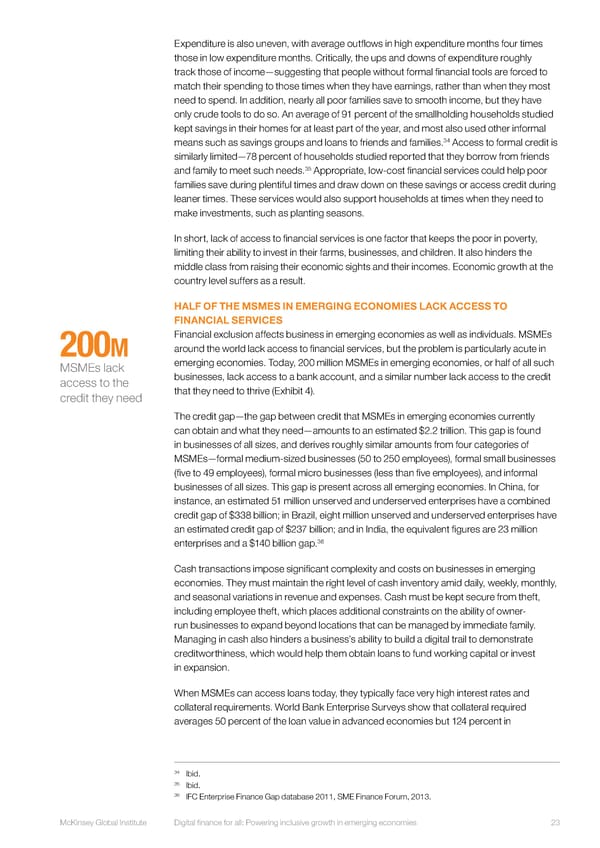Expenditure is also uneven, with average outflows in high expenditure months four times those in low expenditure months. Critically, the ups and downs of expenditure roughly track those of income—suggesting that people without formal financial tools are forced to match their spending to those times when they have earnings, rather than when they most need to spend. In addition, nearly all poor families save to smooth income, but they have only crude tools to do so. An average of 91 percent of the smallholding households studied kept savings in their homes for at least part of the year, and most also used other informal 34 means such as savings groups and loans to friends and families. Access to formal credit is similarly limited—78 percent of households studied reported that they borrow from friends 35 and family to meet such needs. Appropriate, low-cost financial services could help poor families save during plentiful times and draw down on these savings or access credit during leaner times. These services would also support households at times when they need to make investments, such as planting seasons. In short, lack of access to financial services is one factor that keeps the poor in poverty, limiting their ability to invest in their farms, businesses, and children. It also hinders the middle class from raising their economic sights and their incomes. Economic growth at the country level suffers as a result. HALF OF THE MSMES IN EMERGING ECONOMIES LACK ACCESS TO FINANCIAL SERVICES Financial exclusion affects business in emerging economies as well as individuals. MSMEs 200M around the world lack access to financial services, but the problem is particularly acute in MSMEs lack emerging economies. Today, 200 million MSMEs in emerging economies, or half of all such access to the businesses, lack access to a bank account, and a similar number lack access to the credit credit they need that they need to thrive (Exhibit 4). The credit gap—the gap between credit that MSMEs in emerging economies currently can obtain and what they need—amounts to an estimated $2.2 trillion. This gap is found in businesses of all sizes, and derives roughly similar amounts from four categories of MSMEs—formal medium-sized businesses (50 to 250 employees), formal small businesses (five to 49 employees), formal micro businesses (less than five employees), and informal businesses of all sizes. This gap is present across all emerging economies. In China, for instance, an estimated 51 million unserved and underserved enterprises have a combined credit gap of $338 billion; in Brazil, eight million unserved and underserved enterprises have an estimated credit gap of $237 billion; and in India, the equivalent figures are 23 million 36 enterprises and a $140 billion gap. Cash transactions impose significant complexity and costs on businesses in emerging economies. They must maintain the right level of cash inventory amid daily, weekly, monthly, and seasonal variations in revenue and expenses. Cash must be kept secure from theft, including employee theft, which places additional constraints on the ability of owner- run businesses to expand beyond locations that can be managed by immediate family. Managing in cash also hinders a business’s ability to build a digital trail to demonstrate creditworthiness, which would help them obtain loans to fund working capital or invest in expansion. When MSMEs can access loans today, they typically face very high interest rates and collateral requirements. World Bank Enterprise Surveys show that collateral required averages 50 percent of the loan value in advanced economies but 124 percent in 34 Ibid. 35 Ibid. 36 IFC Enterprise Finance Gap database 2011, SME Finance Forum, 2013. McKinsey Global Institute Digital finance for all: Powering inclusive growth in emerging economies 23
 DIGITAL FINANCE FOR ALL Page 34 Page 36
DIGITAL FINANCE FOR ALL Page 34 Page 36